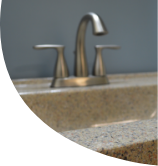RUST: Your Tubs’ Silent Killer
What is rust?
We can’t talk rust without first talking iron, but in layman’s terms rust is just a chemical reaction. When metal, specifically iron (or iron alloys like steel), are exposed to oxygen and moisture for extended periods of time then iron oxide begins to form. The technical definition of oxide is when oxygen and metal combine at an atomic level, which essential weakens the bonds of the metal itself. Long story short, rust causes the metal to expand creating large amounts of structural pressure and potentially damage if not treated properly.
Why Should You Be Concerned About Rust?
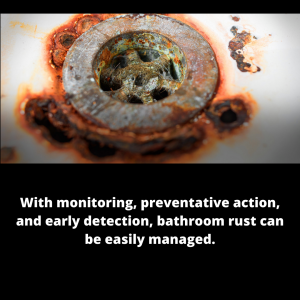
Beyond the health related issues that could arise thanks to rust, you also need to worry about structural damage. Pretty much anywhere there is iron or an iron alloy, you should be concerned about the formation of rust. And what is typically made with iron? Your bathtub! You know it well: it’s large, heavy, and seemly indestructible, right? Unfortunately not, and even the oldest, most formidable bathtubs can fall prey to a simple rusting issue. And if your tub is exhibiting signs of rust it may be time to start taking preventative action, otherwise it could mean the end of your tub in a few years. Although, it can move slowly rust isn’t something to be ignore or trifled with. With monitoring, preventative action, and early detection bathroom rust can be easily managed. Follow our three steps to help eliminate the rust in your own bathroom.
Step 1: Are you sure it’s rust you’re seeing?
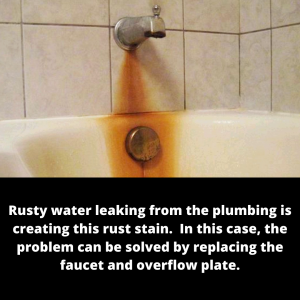

First, let’s make sure what you’re seeing is actually rust and not just stains caused by rust. Hard water stains and soap scum can sometimes build up around your fixtures imitating the pinky-orange color of rust; so make sure you take a look there first to rule it out. Another common cause of rust stains is having older fixtures. If your metal fixtures are aging they could be corroding and rusty causing them to deposit rust stains onto your tub, creating the illusion of rust; when in realty the tub is structurally sound and unharmed by rusting of the adjacent fixtures. If you don’t see any abrasions in the tub’s enamel, and the bare metal is not exposed then chances are it is just stains. And the great news for you is that rust stains are a lot easier to remedy with household cleaning supplies along with minimal time, effort, and money. Even so, after you replace your fixture you’ll still want continue to monitor the rust and staining situation to make sure it doesn’t worsen or return with time. Vigilance is your best friend when it comes to issues such as these.
Step 2: Locate the source of rust

Not stains you’re seeing? The next step here is to locate the origin of the rust. Your best bet is to find where the bare metal is exposedsince that will be the most vulnerable area. In most cases the rust is on the front of the tub and very obvious; for example, chips in the enamel due to something heavy being dropped. And in our experience, if you can’t locate the source of the rust it is most likely on the back side of the tub. And here’s where it can get a little tricky, as you’ll need an access panel to be able to see the backside of your bathtub. If you don’t have one and need one, you can have a professional install an access panel for you or you can cut a hole in your drywall. So if you see rust forming but can’t find out where it’s from, take a look at the back of your tub to rule out this common problem area.
Step 3: Find the solution for you
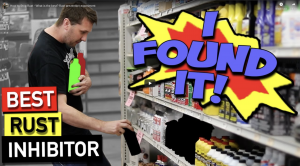
Luckily for you there are tons of YouTube videos and other free content available for the average homeowner to access on the Internet about this very subject. If your rusting issue is minimal and you aren’t ready to seek professional help yet, then the best video to watch for simple fixes is
Fireball Tool’s where they put nine rust inhibitors, that can be found at most hardware stores, to the test. In the end they recommend Sta-Bil Rust Stopper, Minwax Finishing Paste, and WD-40 Special Corrosive to help prevent the spread of rust for average homeowners. But, if your rusting problem is a bit more extensive then there are also some resources for you. For example, TampaSteel’s article titled, “9 Ways to Prevent Metal From Rusting,” provides a lot of insight into the subject in which they provide more in-depth solutions such as galvanizing, regular maintenance, and powder coating among other solutions. Should you feel so inclined to tackle that on your own. Please note, in our professional opinion, depending on the severity of the rust you’ll want to seek professional resurfacing help. These tub refinishing professionals are best equipped and are specially trained to remove and treat rust and damaged metal, ultimately giving your tub the best option for survival.
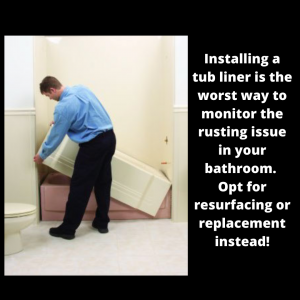
Tub Resurfacing is act of spraying a coating over your existing tub to completely change to color or make it look like new. Even if you opt to not resurface the tub you’ll want to avoid putting a liner over the tub and tile. This just hides the problems under a nice fiberglass case, but it won’t prevent the spread of rust once it has started. In cases where the tub has structural damage due to rust, the last thing you want it the “out of sight out of mind” mentality.
All That Glitters Isn’t…Chrome?
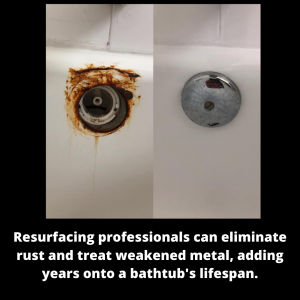
Now we can’t lie to you and say there is a fool-proof solution for treating rust, because there isn’t. All you, as a diligent homeowner, can do is remove what rust you can and keep monitoring the situation. When talking with our customers, we actually compare rust to cancer: in the way that it can be cut out and the symptoms treated; however, no one can guarantee that it won’t eventually return. But you can take solace in the fact that there are reputable companies trained to handle your rusty bathtub which allow for affordable solutions instead of replacement.


